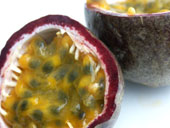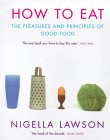
UK/Ireland
•Canada/USA
________________________________________________________________________

eat
passion fruit
The passion fruit has
to be one of the most intensely and enticingly scented of all fruits.
Enjoy passion fruit on their own, on yoghurt or ice cream, or use them
to impart their magical flavor to a variety of fantastic desserts (see
PICK OF THE RECIPES).
HISTORY
Passion fruit are native to the area from southern Brazil through Paraguay to northern Argentina. They were known in Australia by the late nineteenth century from where the seeds were taken to Hawaii.
Passion fruit is now an important commercial crop in Florida, California, Kenya and South Africa.
BIOLOGY
The familiar purple passion fruit come from Passiflora edulis; a climbing plant that vigorously spreads its tendrils across all surfaces. The variety flavicarpa produces yellow-skinned fruit.
NUTRITION
Passion fruit are rich in vitamins A and C and are a good source of potassium and iron. The seeds are high in fiber.
TIPS
BUYING
Choose larger fruit whose weight indicates a reasonable juice content.
The fruit are ripe when the skin is deeply wrinkled.
STORING
Store ripe passion fruit in the fridge. Smooth, unripe passion fruit will
ripen in a few days at room temperature.
Both the fruit and juice freeze well. Ice cubes made from the juice diluted with an equal volume of water can be served with fresh fruit juices or to enliven a glass of water.
PREPARING
If using the pulp and seeds simply cut in half and spoon out the flesh.
To extract the juice, scrape the pulp and seeds against a sieve with a
wooden spoon. A lot of fruit are needed for a little juice, but a little
juice goes a long way.
A syrup made by boiling down the diluted juice with a little sugar further intensifies the flavor and makes a wonderful fruit salad dressing or cocktail ingredient.
OTHER STUFF
Tests have shown that passion fruit juice has a slight sedative effect as a result of the combination of glycosides and flavonoids present. Both the juice and the flowers of the plant have been used in remedies to treat anxiety and high blood pressure. According to Antonio Bernardes' A Pocket Book of Brazilian Herbs:
"2 glasses of juice will naturally calm down the most hyperactive child, and for this reason it is highly valued by Brazilian mothers."
PICK OF THE RECIPES
in
season:
january
february
march
april
may
june
july
august
september
october
november
december
main regions:
California, Hawaii
ONLINE
IN PRINT
-
Passion Fruit Fool
How to Eat -
Simple Passion Fruit Souffle
Very Simple Food


